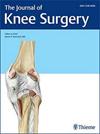髌骨复位是否会增加全膝关节置换术后两年内伸肌机制损伤的风险?
IF 1.6
4区 医学
Q3 ORTHOPEDICS
引用次数: 0
摘要
背景 全膝关节置换术(TKA)后的伸肌机制损伤(EMI)是一种潜在的灾难性并发症,可能导致严重的发病率或需要进行翻修重建手术。髌骨复位(PR)虽然通常在 TKA 期间进行,但会减少整体髌骨骨量,并可能增加 TKA 后发生 EMI 的风险。本研究旨在评估老年患者的髌骨重置术(PR)是否会增加后续 EMI 的风险。方法 对美国关节置换登记处(AJRR)进行查询,以确定在 2012 年 1 月至 2020 年 3 月期间因骨关节炎接受初级选择性 TKA 的年龄≥65 岁的医疗保险患者。收集了患者的年龄、性别和查尔森合并症指数 (CCI)。随后将记录与医疗保险理赔记录合并,并根据 TKA 术后 2 年内的 ICD-9/10 诊断代码评估是否发生髌骨骨折、股四头肌腱断裂或髌腱断裂。根据是否发生 PR 对患者进行分层(NR)。采用 Logistic 回归确定 PR 与 EMI 之间的关系。结果 共有 453,828 例 TKA 符合纳入条件,其中 428,644 例(94.45%)接受了 PR。PR发生率从2012年的96.06%降至2022年的92.35%(P<0.001)。接受 PR 的患者多为女性(60.93% vs. 58.50%;p<0.001),平均 CCI 较低(3.09 [1.10] vs. 3.16 [1.20];p<0.001)。EMI的几率并不因是否进行PR而不同(OR:0.85 [0.65-1.11];P=0.2246)。年龄(OR:1.06 [1.05-1.07],p<0.0001])和 CCI(OR:1.06 [0.95-1.19],p=0.0009)的增加与 EMI 相关。结论 在美国,TKA 期间通常会进行 PR,在年龄≥65 岁的患者中,PR 并未发现会增加 TKA 术后 2 年内发生 EMI 的几率。年龄和并发症的增加与随后发生 EMI 的几率增加有关。本文章由计算机程序翻译,如有差异,请以英文原文为准。
Does Resurfacing the Patella Increase the Risk of Extensor Mechanism Injury Within the First Two Years After Total Knee Arthroplasty?
Background Extensor mechanism injury (EMI) following total knee arthroplasty (TKA) is a potentially catastrophic complication and may lead to significant morbidity or need for revision reconstructive procedures. Patella resurfacing (PR), while commonly performed during TKA, reduces overall patella bone stock and may increase the risk of EMI after TKA. The purpose of this study was to assess if patellar resurfacing (PR) in elderly patients raises the risk for subsequent EMI. Methods The American Joint Replacement Registry (AJRR) was queried to identify Medicare patients ≥65 years old undergoing primary elective TKA for osteoarthritis between January 2012 and March 2020. Patient age, sex, and Charlson Comorbidity Index (CCI) were collected. Records were subsequently merged with Medicare claims records and evaluated for the occurrence of patella fracture, quadriceps tendon rupture, or patellar tendon rupture based on ICD-9/10 diagnosis codes within 2 years of TKA. Patients were stratified based on whether PR occurred or not (NR). Logistic regression was used to determine the association between PR and EMI. Results A total of 453,828 TKA were eligible for inclusion and 428,644 (94.45%) underwent PR. The incidence of PR decreased from 96.06% in 2012 to 92.35% in 2022 (p<0.001). Patients undergoing PR were more often female (60.93% vs 58.50%; p<0.001) and had a lower mean CCI (3.09 [1.10] vs. 3.16 [1.20]; p<0.001). Odds for EMI did not differ based on whether PR was performed (OR: 0.85 [0.65-1.11]; p=0.2246). Increasing age (OR: 1.06 [1.05-1.07], p<0.0001]) and CCI (OR: 1.06 [0.95-1.19], p=0.0009) were associated with EMI. Conclusions PR is commonly performed during TKA in the United States and was not found to increase odds for EMI within 2 years of TKA in patients ≥65 years old. Increased age and medical comorbidity were associated with higher odds for subsequent EMI.
求助全文
通过发布文献求助,成功后即可免费获取论文全文。
去求助
来源期刊

Journal of Knee Surgery
ORTHOPEDICS-
CiteScore
4.50
自引率
5.90%
发文量
139
期刊介绍:
The Journal of Knee Surgery covers a range of issues relating to the orthopaedic techniques of arthroscopy, arthroplasty, and reconstructive surgery of the knee joint. In addition to original peer-review articles, this periodical provides details on emerging surgical techniques, as well as reviews and special focus sections. Topics of interest include cruciate ligament repair and reconstruction, bone grafting, cartilage regeneration, and magnetic resonance imaging.
 求助内容:
求助内容: 应助结果提醒方式:
应助结果提醒方式:


